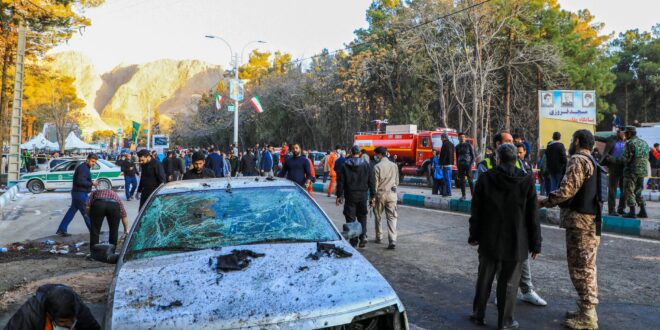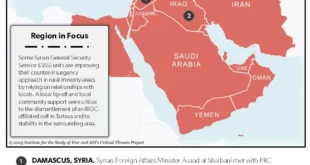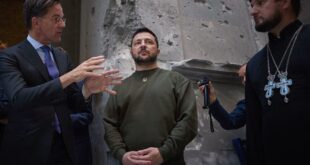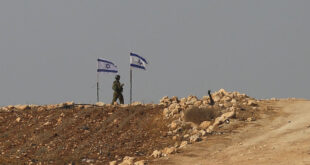The group, which has struck before in Iran, has a long history of division with the country.
The Islamic State claimed responsibility on Thursday for the bombing attack that killed 84 people in Kerman, Iran, a day before, during a memorial procession for Maj. Gen. Qassim Suleimani, according to a post on the extremist group’s official Telegram account.
The extremist group called the attack a “dual martyrdom operation,” and described how two militants approached a ceremony at the tomb of General Suleimani and detonated explosive belts strapped to their bodies “near the grave of the hypocrite leader.”
The general, a widely revered and feared Iranian military officer who was the architect of an Iranian-led and -funded alliance of Shiite groups across the Middle East, was assassinated four years ago in an American drone attack.
The Islamic State, a Sunni Muslim organization, considers its mission to kill apostate Muslims, including Shiites. Iran, a majority-Shiite country, is led by a theocratic government in which Shiite clerics are in charge.
In a statement, the Islamic State identified the two attackers as Omar al-Mowahid and Sayefulla al-Mujahid. The group is composed of local affiliates across the Muslim world, but it did not specify which regional organization was behind the bombings.
The bombing in Iran was the latest bloody episode in the Islamic State’s targeting of Iran, which it considers an irredeemable sectarian foe, one that, along with a U.S.-led coalition, had a hand in defeating the group in Syria and Iraq. It was General Suleimani who built a network of Shiite militias there to repel the group and personally directed efforts to fight it.
The Islamic State, whose affiliate in Afghanistan, ISIS-Khorasan, has repeatedly threatened Iran over what it says is its polytheism and apostasy, has claimed responsibility for several previous attacks on Iran.
The most recent came in October 2022, when a gunman killed 13 people at a shrine in the city of Shiraz. An Islamic State statement claiming responsibility for that attack said it had aimed to kill Shiites — framing the shootings as the continuation of an ancient clash between Sunnis and Shiites, whose religious schism goes back to a seventh-century dispute over the rightful heir to the Prophet Muhammad.
Thursday’s statement used the same derogatory term for Shiites, roughly translated as “rejectionists” or “refusal infidels,” as in the 2022 statement.
The Shiraz shooting followed twin attacks in June 2017 on Tehran, where gunmen opened fire inside Parliament and suicide bombers simultaneously struck near the mausoleum of Ayatollah Ruhollah Khomeini, Iran’s former supreme leader and founder of Iran’s clerical state, killing 17. The group also claimed a September 2018 attack in the city of Ahvaz, where gunmen shot at a military parade, killing 25.
The Iranian authorities have also previously announced they had thwarted at least a dozen more Islamic State attacks.
Some Iranian leaders had initially appeared to blame Israel for the attack, stoking fears that the war in Gaza — in which Israel is battling Hamas, a Palestinian ally of Iran — would widen into a regional conflict. But Western officials had cast doubt on that theory, saying that although Israel is believed to have regularly carried out covert operations in Iran, they have typically been targeted operations against specific individuals, Iranian scientists or officials, or strikes to destroy nuclear or weapons facilities.
American officials said that it was unlikely that the Islamic State’s intention was to frame Israel for the bombings or set off a wider war, as had been initially feared. Instead, it was probably seizing an opportunity to hit its longtime enemy. Iran held a national day of mourning on Thursday to honor victims of the twin explosions, which occurred not only at a tense moment in the Middle East, but also on a highly symbolic day for some Iranians — the fourth anniversary of General Suleimani’s death. General Suleimani, the powerful military leader regarded as a malign force in the West, is revered among many Iranians, especially those who support the government.
Iranian officials had put the death toll for the two blasts at 103 on Wednesday. But the interior minister, Ahmad Vahidi, said on Thursday that 84 people had been killed, according to Tasnim, a semiofficial news agency.
Speaking during a visit to a hospital that was treating people wounded in the explosions, Mr. Vahidi said the death toll might rise again because of the grave condition of some of the injured. A total of 284 people were wounded in the attack, including 220 still hospitalized in Kerman, many of whom were in stable condition or requiring minor surgeries, he said, according to Tasnim.
Iran’s leaders have vowed to punish the perpetrators.
“The blind and spiteful act was to induce insecurity in the country and take revenge on the love and devotion of the great nation of Iran, especially the zealous young generation, to the martyr Qassim Suleimani,” read a statement released Thursday by the Islamic Revolutionary Guards Corps, according to Fars, another semiofficial news agency. The Revolutionary Guard Corps is the powerful military-security apparatus where General Suleimani was a top officer, heading the elite Quds Force, which handled external operations.
Mick Mulroy, who served as a Pentagon official in the Trump administration, said there was “no love lost” between the Islamic State and Iran. “But it does seem like an odd time to launch an attack with the current conflict in Gaza and the unified Muslim support for the Palestinians,” he said.
Though the Islamic State did not specify an affiliate behind the attack, Colin P. Clarke, a counterterrorism analyst at the Soufan Group, a security consulting firm based in New York, said he suspected that the Islamic State’s Khorasan affiliate, also known as ISIS-K, as the likely perpetrator.
“ISIS-K has demonstrated both intent and capability to attack targets inside Iran proper,” Mr. Clarke said. “ISIS-K wants to attack Iran, because Tehran is the most prominent Shia power and the ire of ISIS-K’s highly sectarian agenda. More so than other ISIS branches, ISIS-K propaganda continuously focuses on denigrating Shia as apostates.”
Mr. Clarke said the attack at the commemoration ceremony, a highly symbolic and sectarian target given General Suleimani’s stature as the architect of the Tehran-led Shiite axis in the region, fit the group’s method.
Tasnim, the news agency, reported that the first explosion occurred at 3:04 p.m. Wednesday as people crowded the road leading toward General Suleimani’s tomb. The second blast came 13 minutes later, it said.
The Islamic State’s claims of responsibility contrasted with initial Iranian reports that the bombs had been placed in two bags and remotely detonated along the road to the cemetery in Kerman, where thousands of people taking part in the commemoration were walking.
Another semiofficial news agency, IRNA, quoted a police spokesman as saying that three police officers had been killed in the explosions while trying to help other victims.
The commemoration ceremony was held to mark the fourth anniversary of General Suleimani’s assassination at Baghdad airport in January 2020. Similar ceremonies honoring the general are held annually.
 Eurasia Press & News
Eurasia Press & News



